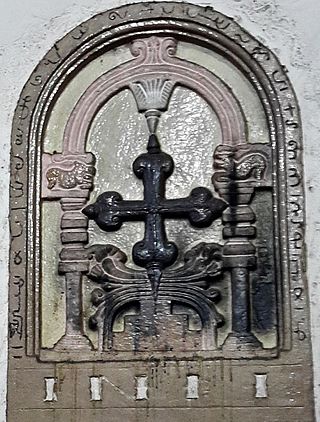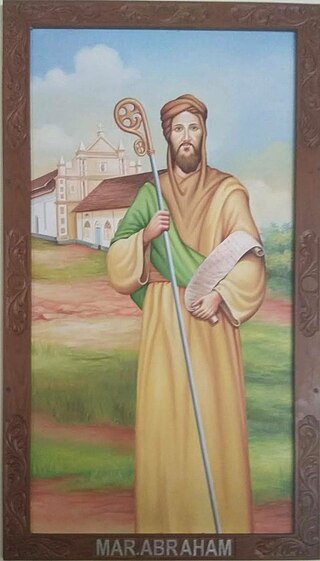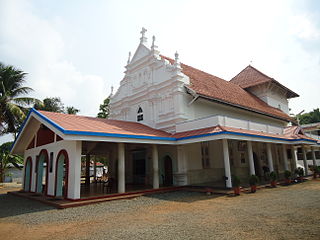
The Saint Thomas Christians, also called Syrian Christians of India, Marthoma Suriyani Nasrani, Malankara Nasrani, or Nasrani Mappila, are an ethno-religious community of Indian Christians in the state of Kerala, who, for the most part, employ the Eastern and Western liturgical rites of Syriac Christianity. They trace their origins to the evangelistic activity of Thomas the Apostle in the 1st century. The Saint Thomas Christians had been historically a part of the hierarchy of the Church of the East but are now divided into several different Eastern Catholic, Oriental Orthodox, Protestant, and independent bodies, each with their own liturgies and traditions. They are Malayalis and speak Malayalam. Nasrani or Nazarene is a Syriac term for Christians, who were among the first converts to Christianity in the Near East.

The Syro-Malabar Catholic Church, is an Eastern Catholic Church based in Kerala, India. It is sui iuris (autonomous) particular Church in full communion with the Pope and the worldwide Catholic Church, including the Latin Church and the 22 other Eastern Catholic Churches, with self-governance under the Code of Canons of the Eastern Churches (CCEO). The Church is headed by the Major Archbishop of the Syro-Malabar, currently George Alencherry. The Syro-Malabar Synod of Bishops canonically convoked and presided over by the Major Archbishop constitutes the supreme authority of the Church. The Major Archiepiscopal Curia of the Church is based in Kakkanad, Kochi. Syro-Malabar is a prefix reflecting the church's use of the East Syriac Rite liturgy and origins in Malabar. The name has been in usage in official Vatican documents since the nineteenth century.

The Synod of Diamper (Udayamperoor Synod) (Malayalam: ഉദയംപേരൂർ സൂനഹദോസ്, romanized: Udayampērūṟ Sūnahadōs), held at Udayamperoor (known as Diamper in non-vernacular sources) in June 1599, was a diocesan synod, or council, that created rules and regulations for the ancient Saint Thomas Christians (also known as Mar Thoma Nasranis) of the Malabar Coast, a part of modern-day Kerala state, India, formally subjugating them and downgrading their whole Metropolitanate of India as the Diocese of Angamale, a suffragan see to the Archdiocese of Goa administered by Latin Church Padroado missionaries. This synod also introduced forced Liturgical Latinisation and the eschewal of local practices and beliefs, leading to a significant ecclesial protest by Saint Thomas Christians known as Coonan Cross Oath and a subsequent schism in the mid-17th century.

The Coonan Cross Oath, also known as the Great Oath of Bent Cross, the Leaning Cross Oath or the Oath of the Slanting Cross, taken on 3 January 1653 in Mattancherry, was a public avowal by members of the Saint Thomas Christians of the Malabar region in India, that they would not submit to the Jesuits and Latin Catholic hierarchy, nor accept Portuguese dominance in ecclesiastical and secular life. There are various versions about the oath's wording, one version being that the oath was directed against the Portuguese, another that it was directed against Jesuits, and yet another version that it was directed against the authority of Catholic Church.

The Chaldean Syrian Church of India is an Eastern Christian denomination, based in Thrissur, in India. It is organized as a metropolitan province of the Assyrian Church of the East, and represents traditional Christian communities of the East Syriac Rite along the Malabar Coast of India. It is headed by Mar Awgin Kuriakose.

The Malankara Church, also known as Puthenkur, is the historic unified body of West Syriac Saint Thomas Christian denominations which claim ultimate origins from the missions of Thomas the Apostle. This community, under the leadership of Thoma I, opposed the Padroado Jesuits as well as the Propaganda Carmelites of the Latin Church, following the historical Coonan Cross Oath of 1653. The Malankara Church's divisions and branchings have resulted in the modern-day Churches that include the Jacobite Syrian Christian Church, the Malankara Orthodox Syrian Church, the Malankara Mar Thoma Syrian Church, the Malabar Independent Syrian Church, the Syro-Malankara Catholic Church and the Saint Thomas Anglicans of the Church of South India.

Muttuchira is a village in Kottayam district in the state of Kerala, India.

Palliveettil Chandy also known as Parambil Chandy was a bishop of the Catholic Saint Thomas Christians. He is also the first known native Indian bishop. He was the bishop of the East Syriac Rite (Chaldaean) faction after the Coonan Cross Oath in 1653. This faction returned to full communion with the Holy See of Rome, it would later become known as the modern-day Eastern Catholic Syro-Malabar Church. Mar Chandy's tomb is at the Marth Mariam Major Archiepiscopal Church at Kuravilangad.
The Malankara Rite is the form of the West Syriac liturgical rite practiced by several churches of the Saint Thomas Christian community in Kerala, India. West Syriac liturgy was brought to India by the Syriac Orthodox Bishop of Jerusalem, Gregorios Abdal Jaleel, in 1665; in the following decades the Malankara Rite emerged as the liturgy of the Malankara Church, one of the two churches that evolved from the split in the Saint Thomas Christian community in the 17th century. Today it is practiced by the various churches that descend from the Malankara Church, namely the Malankara Mar Thoma Syrian Church, Malankara Orthodox Syrian Church, the Jacobite Syrian Christian Church, the Syro-Malankara Catholic Church and the Malabar Independent Syrian Church

Metropolitanate of India was an East Syriac ecclesiastical province of the Church of the East, at least nominally, from the seventh to the sixteenth century. The Malabar region (Kerala) of India had long been home to a thriving Eastern Christian community, known as the Saint Thomas Christians. The community traces its origins to the evangelical activity of Thomas the Apostle in the 1st century. The Christian communities in India used the East Syriac Rite, the traditional liturgical rite of the Church of the East. They also adopted some aspects of Dyophysitism of Theodore of Mopsuestia, often inaccurately referred as Nestorianism, in accordance with theology of the Church of the East. It is unclear when the relation between Saint Thomas Christian and the Church of the East was established. Initially, they belonged to the metropolitan province of Fars, but were detached from that province in the 7th century, and again in the 8th, and given their own metropolitan bishop.

The Saint Thomas Christian denominations are Christian denominations from Kerala, India, which traditionally trace their ultimate origins to the evangelistic activity of Thomas the Apostle in the 1st century. They are also known as "Nasranis" as well. The Syriac term "Nasrani" is still used by St. Thomas Christians in Kerala.
Mar Joseph Sulaqa, also known as Yousep d'Bēth Bello, was one of the last East Syriac bishops to Malabar. He was shortly followed by Mar Abraham; both reached in Malabar after the arrival of the Portuguese. Patriarch Abdisho IV Maron (1555–1570), the successor of Shimun VIII Yohannan Sulaqa, sent the brother of Shimun VIII, Mar Joseph, to Malabar as a Chaldaean bishop; although consecrated in 1555 or 1556, Mar Joseph could not reach India before the end of 1556, nor Malabar before 1558, when the Portuguese were finally alerted by the presence of Mar Abraham and allowed Mar Joseph, accompanied by another Chaldaean bishop, Mar Eliah, to occupy his see, before the Inquisition also sent him to Lisbon in 1562.

Abraham of Angamaly was the last East Syrian bishop of the See of Angamaly, who entered into communion with Rome in 1565 and who was the last link in Angamaly from the long line of the bishops from the East Syriac bishops sent from the Church of the East to the Saint Thomas Christians. He first came to India in 1556 from the traditionalist patriarchate. Deposed from his position in 1558, he was taken to Lisbon by the Portuguese, escaped at Mozambique and left for his mother church in Mesopotamia, entered into communion with the Chaldean patriarchate and Rome in 1565, received his episcopal ordination from the Latin patriarch of Venice as arranged by Pope Pius IV (1559–65) in Rome. Subsequently, Abraham was appointed by Pope as Archbishop of Angamaly.

Giwargis of Christ, also spelled Geevarghese of Christ and George of Christ, was an Archdeacon (Arkkadyakon) and hence the leader of the Saint Thomas Christian community of India. He was a biblical expert and a master of Syriac language and literature. He was considered a holy person but extremely efficient in administration. He was contemporary to Archbishop Mar Abraham of Angamaly. He is credited with the new construction of Marth Maryam Church Angamaly

Several historical evidences shed light on a significant Malankara–Persian ecclesiastical relationship that spanned centuries. While an ecclesiastical relationship existed between the Saint Thomas Christians of India and the Church in Sassanid Empire in the earlier centuries, closer ecclesiastical ties developed as early as seventh century, when India became an ecclesiastical province of the Church of the East, albeit restricted to matters of purely ecclesiastical nature such as ordination of priests, and not involved in matters of temporal administration. This relationship endured until the Portuguese protectorate of Cochin of Malabar came to be in 16th century, and the Portuguese discovery of a sea route to India. The Christians who came under the two ancient yet distinct lineages of Malankara and Persia had one factor in common: their Saint Thomas heritage. The Church of the East shared communion with the Great Church until the Council of Ephesus in the 5th century, separating primarily over differences in Christology.

Mar Hormizd Cathedral, locally known as the Eastern Church of Angamaly or the Cathedral Church, is a Syro-Malabar church in Angamaly, India. It was created cathedral in 1577 by Mar Abraham, the last East Syriac Metropolitan to reach Malabar Coast. It is one of the oldest and is historically the most important of the three ancient Syrian churches in Angamaly. It is dedicated to Mar Hormizd, a seventh-century East Syriac saint.

St. Mary's Jacobite Syrian Soonoro Cathedral is an ancient Jacobite Syrian church located in Angamaly built in 1564 by Archdeacon Giwargis of Christ, it is one of the most prominent and ancient Syriac Orthodox churches in Kerala. Akapparambu Church is the most ancient church in Angamaly region and this church was a united parish with Akapparambu church for long time. Hence Akapparambu church was called valiyapally and this church was called cheriyapally in olden days. In the seventeenth century it was the residence of Archdeacon Thomas Parambil, who eventually got consecrated as bishop Mar Thoma I. It was the seat of the Archdeacon and later the Malankara Metropolitans, the local heads of the pre-20th century Malankara Church and hence held an important position in the church for several centuries.
Angamāly Padiyōla is a historic declaration of the Syrian Catholic/ Syro Malabar (Paḻayakūṟ) Saint Thomas Christians proclaimed in 1787 at the Great Church of Saint George in Angamāly. This document made a strong appeal to the pope for the consecration of a native bishop for the community and demanded autonomy for their Church which was forcibly brought under the Latin Church's jurisdiction.

The Paḻayakūṟ (Pazhayakoor) or Romo-Syrians or Syrian Catholics of Malabar refers to the East Syriac denominations of the Saint Thomas Christian Church, which claim ultimate apostolic origin from the Indian mission of Thomas the Apostle in the 1st century AD. The Paḻayakūṟ descends from the faction that remained within the Catholic fold and held fast to an East Syriac identity after the historic Coonan Cross Oath of 1653 while being part of the community seceded from the Portuguese Padroado. The modern descendants of the Paḻayakūṟ are the Syro-Malabar Church and the Chaldean Syrian Church. Among these, the former is an Eastern Catholic church in full Communion with the Holy See and the latter is an integral part of the Assyrian Church of the East, one of the traditionalist descendants of the Church of the East.










